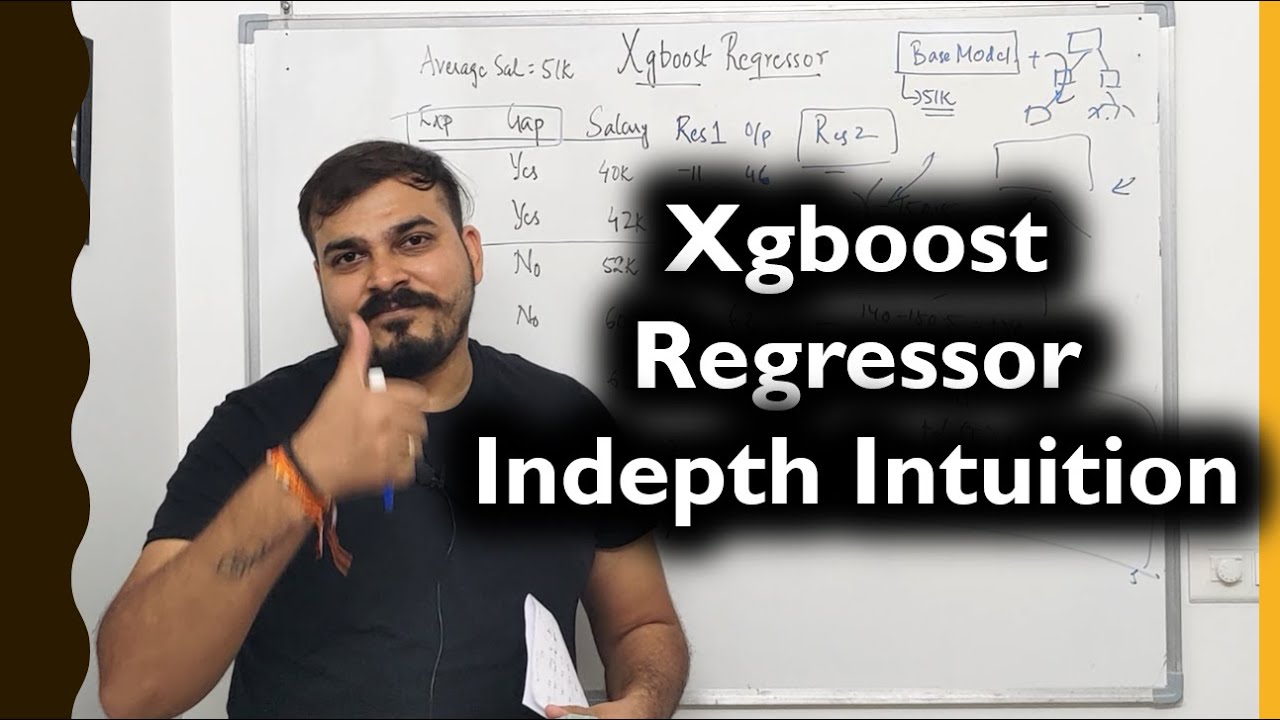Maths behind XGBoost|XGBoost algorithm explained with Data Step by Step
Summary
TLDRIn this data science tutorial, Aman explains the mathematical foundation of the XGBoost algorithm, an advanced machine learning technique. He begins with an overview of boosting algorithms, emphasizing their sequential learning approach compared to bagging. Aman then delves into XGBoost's unique features like regularization, auto-pruning, and the importance of parameters like lambda, gamma, and eta. Using a simple dataset, he illustrates how XGBoost models are trained iteratively to minimize prediction errors and handle outliers. The video promises a follow-up on implementing XGBoost in Python and exploring its parameters' impact.
Takeaways
- 🌟 XGBoost is a boosting algorithm that builds models sequentially, with each new model attempting to correct the errors of the previous ones.
- 🔍 Boosting differs from bagging in that it is a sequential ensemble method, training models one after another, whereas bagging is parallel.
- 📊 XGBoost extends the Gradient Boosting algorithm, which uses decision trees and focuses on reducing the residuals of predictions.
- 📈 The script uses a simple dataset with age as the independent variable and IQ as the dependent variable to illustrate how XGBoost works.
- 🔢 Lambda is a regularization parameter in XGBoost that helps control overfitting by adjusting the impact of residuals on the model.
- 🌱 Gamma is a threshold parameter in XGBoost that controls auto-pruning of the trees, thus preventing overfitting.
- 🚀 Eta, or the learning rate, determines how quickly the boosting models converge to the final prediction.
- 🌳 XGBoost creates a base model first, often starting with a simple average, and then fits additional models on the residuals of the previous model's predictions.
- 📉 The residuals are used to build subsequent trees in the boosting process, with each tree attempting to minimize the error of the previous model.
- 🛠️ The script explains how parameters like Lambda, Gamma, and Eta influence the model's ability to handle outliers and prevent overfitting.
Q & A
What is XGBoost?
-XGBoost stands for eXtreme Gradient Boosting. It is a machine learning algorithm that is an optimized distributed gradient boosting library. It is designed to be highly efficient, flexible, and portable. It implements machine learning algorithms under the Gradient Boosting framework.
What is the difference between a boosting algorithm and a bagging algorithm?
-A boosting algorithm is a sequential ensemble technique where models are trained one after another, with each new model trying to correct the errors of the previous ones. In contrast, a bagging algorithm is a parallel ensemble technique where multiple models are trained independently and then combined.
How is XGBoost different from Gradient Boosting?
-XGBoost is an extension of Gradient Boosting. It adds features like regularization, auto pruning, and a more flexible definition of the objective function, making it more effective in preventing overfitting and handling large scale data.
What is the role of lambda in XGBoost?
-Lambda in XGBoost is a regularization parameter that controls the complexity of the model. It helps in controlling overfitting by penalizing the size of the trees, thus acting as an aggressive pruning parameter.
What does gamma represent in the context of XGBoost?
-Gamma in XGBoost is a threshold for minimum loss reduction required to make a further partition on a leaf node of the tree. It helps in controlling overfitting by preventing the model from learning noise from the training data.
What is the significance of the eta parameter in XGBoost?
-Eta, also known as the learning rate in XGBoost, controls how fast the model learns. It shrinks the feature weights after each boosting step to prevent overfitting. A smaller eta means a slower rate of convergence.
How does XGBoost handle outliers?
-XGBoost handles outliers by using the lambda parameter. By increasing the value of lambda, the impact of outliers on the prediction is reduced, as it effectively neutralizes the effect of extreme data points.
What is the base prediction model in the given example?
-In the provided example, the base prediction model is the average of the target values. It predicts the IQ based on the average age of the students.
How does the residual value change after the first model in XGBoost?
-After the first model, the residual values change based on the difference between the actual values and the predictions made by the model. These new residual values are then used to train the next model in the sequence.
What is the concept of similarity score in XGBoost?
-The similarity score in XGBoost is a measure used to determine the homogeneity of residuals at a node. It is calculated as the sum of squared residuals divided by the number of residuals plus lambda. It plays a crucial role in deciding whether to split a node or not.
How does XGBoost reduce the residual error?
-XGBoost reduces the residual error by sequentially fitting new models on the residuals of the previous model. Each new model aims to correct the errors of the previous ones, thus gradually reducing the overall residual error.
Outlines

Этот раздел доступен только подписчикам платных тарифов. Пожалуйста, перейдите на платный тариф для доступа.
Перейти на платный тарифMindmap

Этот раздел доступен только подписчикам платных тарифов. Пожалуйста, перейдите на платный тариф для доступа.
Перейти на платный тарифKeywords

Этот раздел доступен только подписчикам платных тарифов. Пожалуйста, перейдите на платный тариф для доступа.
Перейти на платный тарифHighlights

Этот раздел доступен только подписчикам платных тарифов. Пожалуйста, перейдите на платный тариф для доступа.
Перейти на платный тарифTranscripts

Этот раздел доступен только подписчикам платных тарифов. Пожалуйста, перейдите на платный тариф для доступа.
Перейти на платный тарифПосмотреть больше похожих видео

XGBoost Explained in Under 3 Minutes

Xgboost Regression In-Depth Intuition Explained- Machine Learning Algorithms 🔥🔥🔥🔥

Gradient descent simple explanation|gradient descent machine learning|gradient descent algorithm

M4ML - Linear Algebra - 1.1 Introduction: Solving data science challenges with mathematics

TEKNIK CLUSTERING UNTUK MENGANALISA DATA MAHASISWA

Naive Bayes dengan Python & Google Colabs | Machine Learning untuk Pemula
5.0 / 5 (0 votes)
